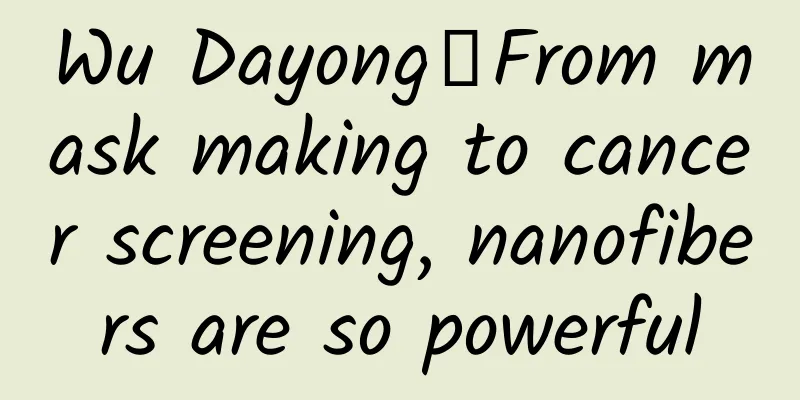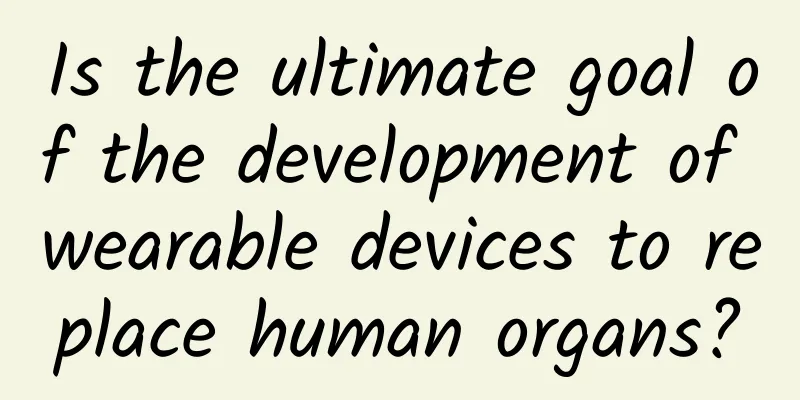Wu Dayong丨From mask making to cancer screening, nanofibers are so powerful

|
A distance as short as one millimeter, In fact, it can hold twenty hairs. How many nanofibers can be placed in one millimeter? Probably about 10,000 or 20,000. Hello everyone, I am Wu Dayong, from the Institute of Physics and Chemistry of the Chinese Academy of Sciences. Today, the topic of my popular science lecture is "Wonderful Nanofibers". Before I start talking about nanofibers, I would like to ask you two questions: What fibers are there in nature? Are there any artificially synthesized fibers? In our daily life, the most common biological fiber is actually cotton. The clothes we wear and the quilts we cover are all made of cotton fibers, as well as the loofahs we used to wash dishes. These are all plant fibers from plants and crops. Among animal fibers, wool is most closely related to our lives, and the other is silk. Does our human body have fibers? Yes, it is hair. You may have heard of acrylic and modal, which are synthetic fibers. The fiber that adds elasticity to our clothes is called Lycra. In fact, fibers are everywhere. They refer to continuous or discontinuous filamentous materials. Nano is a unit of length, which is one millionth of a millimeter. In such a short distance of one millimeter, 20 strands of hair can actually be placed. How many nanofibers can be placed in one millimeter? About 10,000 or 20,000. We call fibers with a diameter of nanometers nanofibers. When the size of a material reaches the nanometer scale, it will have different properties than before. And these properties are often very important. That's why we need to study nanofibers. First, we need to take a look at how such fine nanofibers are made. The technology used to make it is called electrospinning. This is not a new technology. It was invented in 1934, more than 80 years ago. The principle is very simple. A tube is used to transport the polymer solution to a metal nozzle. The metal nozzle is very thin, about the same as the needle used for injections in hospitals. The nozzle is connected to a DC high voltage, and a metal receiving device is placed opposite it. The device can be a flat plate or other shapes. As a result, a high-voltage electric field is generated between the nozzle and the receiving device. There is electrostatic force between the high-voltage electric field, which can pull the polymer solution into filaments. You can see that when the power is turned on, a droplet at the needle tip is gradually stretched and then suddenly ejected. Is the ejected filament thin? Of course it is thin, because it is nanometer-level. You may ask, why do we see a clump ejected all at once when it should be a spiral filament? This is because our eyes are not that fast and cannot capture it clearly. If we repeat this process with a high-speed camera, we will know the answer. Please watch the animation above. It is at 14:28:12. We can see that the end of a thread is whipping in a spiral. The reason why the 12th second seems so long is because it was filmed with an ultra-high-speed camera. The video is 16 seconds long, but it only took 0.3 seconds to film it. In other words, the video was slowed down more than 500 times, so we can see the process of its generation clearly. The process of electrospinning is very interesting. When a drop of polymer solution is placed in an electric field, the electric field force will stretch it, make it sharp, and continue to stretch it to form a cone, and finally a thin nano jet will be ejected. When the nano jet is stable, the small cone will shrink back and form a stable state. The academic name of this cone is called Taylor cone. This process has many very significant mechanical characteristics, including electric field force, including repulsion between charges, gravity, and the mechanical characteristics of springs. Below is an electrospinning production line that my colleagues and I made ten years ago. It is more than 50 meters long and integrates more than 40 nozzle groups, each of which has more than a dozen nozzles. The original principle device only had one nozzle, which was relatively inefficient. If we, as scientific researchers, want to continue to develop a scientific technology and make it viable and practical, we need to use our intelligence to create and promote its development. There is more than one school of electrospinning technology. This is a machine for making nanofibers invented by scientists in the Czech Republic. They are very proud to call it the "Nano Spider". This is also a process for producing nanofibers, and it is different from the method we use. The most significant difference is that our device has a nozzle, but it does not have a nozzle, but uses a metal wire. The reciprocating device in the video is to replenish the raw materials for the metal wire. Both methods have their own advantages, but the "nano spider" still has disadvantages. First, its raw material supply is not continuous, so the length of the silk is limited; second, it can only be sprayed from the bottom up. Our needle-shaped nozzle electrospinning device has another unique skill: it can produce many nanofibers with special shapes. For example, the left side of the picture above is sprayed with a needle, but these fibers are deposited on our collection device, and their arrangement is irregular. Can we make them regular? This is difficult, but there are ways to do it. If we use two parallel electrodes to build a receiving device, the nanofibers produced in this way can be arranged in parallel (upper right of the picture above). What if this receiving electrode is made cross-shaped? Then the received nanomaterials can form a cross structure (lower right of the picture above). Of course, it can also be woven into other structures and shapes, but there is a prerequisite: we need to design the electrodes of the receiving device well. More than a decade ago, my team and I made an electrospinning device, designed a lot of mesh patterns on the receiving device of the device, and obtained the fiber membrane with a fishing net structure as shown above. These pictures also show the unique skills of needle electrospinning. There is a ruler under each picture. Such a small scale cannot be distinguished by the naked eye and can only be seen with a scanning electron microscope. This is the microscopic structure of the fiber. The very thin fiber on the left is hollow, like a tube, and three partitions can be implanted in the fiber. The one in the middle is even more amazing. In the middle of the small tube with a diameter of several hundred nanometers, a thinner fiber can be implanted. The one on the right has many holes on the surface. It has a porous structure and is very loose. It can be used to load catalysts, drugs, or achieve some special design purposes. In addition, if we mix many kinds of pigments together and inject them into the electrospinning nozzle, we can get colorful, entangled and beautiful fibers like the one shown above. If we have more creative ideas, we can also change the preparation method and equipment to make nanofibers with crystals or long rods on the fibers. We can even make such special lattice membrane materials in very small dimensions; we can even use electrospinning to make artificial blood vessels. There are many more structural styles, and the only limit is our imagination. As long as we use our ingenuity and innovative methods, we can get a lot of magical things. In daily life, cotton is very common, but its fiber is relatively thick. So can we get nanofiber cotton? Of course we can. As long as we make a special electrospinning device like the one in the picture above, we can spin something like a cotton boll. I have introduced the basic knowledge and preparation methods of nanofibers. Now I would like to share how to conduct scientific research around nanofibers. Let me start with a simple explanation. In the winter of 2017, Beijing's air pollution was particularly severe. One night, I took a test with an instrument and found that the PM10 reached about 2,000. I began to suspect that ordinary masks might not be effective enough. What should I do? Then I made one myself. So, we made masks with nanofibers as filter materials. Nanofibers are charged, and those polluting PM2.5 and PM10 are often also charged. Different types of charges attract each other, which can fix and capture pollutant particles. Based on this principle, we made masks with a protection capacity of up to 98%. It is lighter than ordinary masks, more breathable, and not stuffy to wear, while also improving the protection efficiency. When the Spring Festival in 2020 came, masks were not available anywhere in the country, but we still had so many good masks. So we distributed these protective masks to everyone, to those in need. During the epidemic, we used this small mask to help thousands of people. ▲ Using the properties of nanofibers to adsorb charged particles Protective mask with filtration efficiency up to 98% The following story is even more interesting. I used 3D printing to make a nanofiber mask. Why did I do this? Once, I secretly put a mask on my face at home, wanting to experience what it felt like. Later, I found it was quite uncomfortable because the mask did not fit my face shape and was uncomfortable to wear. Then I thought, I should make a comfortable one for myself: I used 3D scanning to build a model of my face shape, printed a hard mold, and then used electrospinning to make a mask for myself on the hard mold. What do you think of this mask? Is it cool? We can also inject various nutrients, medicines for treating diseases, etc. into this mask, which is very good. As mentioned earlier, although nanofibers are thin, they can become hollow and have holes on the surface. Based on this condition, what effect will it have if you put drugs inside? They will be slowly released through the holes on the surface of the fiber. The drug you take may last for 1 hour, but if you put it in a fiber with holes, it can be released evenly over 12 hours or longer. This is called sustained release of drugs. There is also a very interesting technology: since drugs can be loaded into nanofibers, can we use such nanofibers to kill cancer cells? We also conducted a study: loading nanofibers with substances that can produce cancer cell-killing substances under light conditions. The dots in the upper picture are all cancer cells. The left column did not contain cancer cell-killing drugs, while the right column did. After a short period of time, the result was that there were more cancer cells on the left, indicating that the drug on the right worked. There are also some red dots in the lower right picture, which are killed cancer cells. There is another very interesting study. Cancer is a major killer that threatens human health, but cancer screening in hospitals is troublesome and expensive. Can we use a simple method, like using pH test paper to test the acidity and alkalinity of water, to identify cancer cells in the blood? ▲ The lower side is the nanofiber membrane substrate After more than three years of hard work, we finally invented it. First, we made a nanofiber membrane with a lot of pores. This is the fiber membrane after being magnified many times, and you can see that there are many holes on the fiber. Then, we fixed the antibodies that can capture tumor markers on this membrane. What is a tumor marker? When a tumor grows in the human body, it metabolizes some products into the blood for the purpose of survival. When the concentration of the metabolites is detected to exceed the normal range, we can find that there is a tumor in the human body. Therefore, we fixed the protein that captures tumor markers on the nanofiber membrane and added color-developing colloidal gold particles. When the sample contains tumor markers, it will show color and be sensitively captured by the detector. Based on the color development of the marker, we have made some designs on the membrane. When the concentration of the marker exceeds the normal value, the membrane begins to develop color, from colorless to light pink. As the concentration of the marker increases, its color will become darker and darker. This test can easily and intuitively determine whether the patient's serum contains excessive tumor markers. In the past two years, we have also cooperated with hospitals, hoping to promote the research results to clinical applications. There is a scientific research called tissue engineering, which uses artificial methods to culture cells into tissues and further grow them into organs. There are many related studies underway, including muscle cells, cardiomyocytes, arterial valves, mesenchymal stem cells, skin tissue, bones, blood vessels, etc. What is the most ideal medium for culturing cells in tissue engineering? The answer is nanofibers made by electrospinning. There is no better or more suitable material than it. The video above shows the effect of culturing cells with nanofibers we made. In addition, we also used nanofibers to make tubular scaffolds in the laboratory and cultured smooth muscle cells and vascular endothelial cells to simulate blood vessels. The blood vessels of the human body are composed of smooth muscle cells and endothelial cells, and there are many layers. We need to make scaffolds in different layers to culture different cells, and then roll them in a tube to simulate real blood vessels. The 16 pictures on the left show the detection of different cell growth in different stent positions, showing that the smooth muscle cells and endothelial cells in the vascular stent grow well. The right side shows a slice of an artificially cultured blood vessel, which has grown completely into a ring. Why do we study nanofibers? Part of the reason is based on national needs, and part of the reason is based on my interest in scientific research. The picture on the left is a picture of me when I was a child. My favorite book at that time was called "Little Smart Wandering in the Future". When I was a child, I had two ideals. The first was to be admitted to the High School Affiliated to Renmin University after graduating from elementary school; the second was to become a naval soldier when I grew up and defend the motherland. Later, I was admitted to the High School Affiliated to Renmin University, but I did not become a naval soldier. However, when I grew up, I gradually realized that you don’t have to be a soldier to defend the motherland, you can also be a scientist. We can still defend the motherland by researching new technologies and weapons. In the movie Spider-Man, the protagonist can spray fibers with just a stretch of his hand. I wondered: Is this nanofiber? Why is it so strong? Is it possible for us to create such a material? I hope everyone can maintain a curious heart and a spirit of exploration to create the glory that belongs to you. That’s all for my speech, thank you! - END - The articles and speeches only represent the author’s views and do not represent the position of the Gezhi Lundao Forum. |
<<: Faster evolution means faster extinction?
Recommend
The most popular marketing copywriting skills in 2020!
If you want to write a popular marketing promotio...
Ministry of Industry and Information Technology: 107 apps that refused to rectify have been removed from shelves this year, and rectification efforts will be intensified
[[394514]] On April 20, the State Council Informa...
He lost his teaching position because of "not doing his job properly", but he became a master
Isaac Asimov showed outstanding creative talent s...
Rocket: I want to fly...higher!
China Space Day Special The Road to Flying It'...
Chaohu Mini Program Production Company, how much does it cost to make a luggage mini program?
How much does it cost to produce the Chaohu lugga...
The most comprehensive mind map: How to trigger user growth?
In fact, user growth systems are very common in o...
Hackers vs. smart cars: Count the models that failed
Cars are no longer just a means of transportation...
What to do if you have a "double positive"? Authoritative answers
Recently, some people have tested positive for CO...
Why does a mosquito bite make it itch more the more I scratch it?
Audit expert: Jiang Tao Vice Chairman of the Scie...
How to play Douyin to make money out of nothing, earn thousands of yuan a day with zero cost!
There is no doubt that you can make money on Douy...
I have a user portrait, but why can’t I understand the user?
The concept of user portrait has been around for ...
Baidu is promoting these "auxiliary functions" through bidding, so be careful!
When it comes to bidding promotion, Baidu can be ...
Floor height ≥ 3, sound insulation +1... This is what the "new house" will look like in the future →
The Ministry of Housing and Urban-Rural Developme...
Better to live a miserable life than to die? Compatible with Android and iOS: Windows loses its platform advantage
Following the delivery of Microsoft's killer ...
"Bang!" It exploded! A loud noise in the early morning woke up the whole family! Many people have this thing at home
Recently, Yancheng, Jiangsu A family slept until ...









